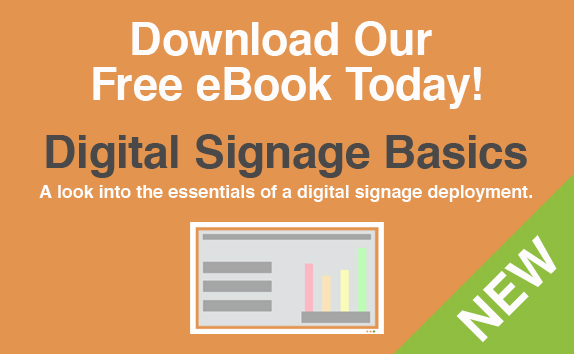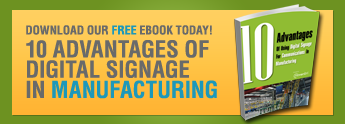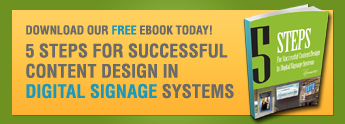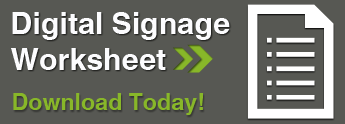007 – Content Strategy and Philosophy For Digital Signage
3 common areas for Digital Signage placement are in the Lobby, Break Room, and Factory Floor. How does the type of audience and the contents purpose influence how and when your message is displayed?
Martin and Robb discuss this topic and more in Episode 7 of the Digital Signage Works Podcast.
Links:
Download our eBook – 10 Advantages of Digital Signage in Manufacturing
Article – 5 Steps to Building Effective Metric Display Content
Transcript:
ML: Alright, well, welcome everyone to Digital Signage Works podcast episode seven. In this episode we’re going to talk about content strategy. Digital signage philosophy. You got your thinking cap on Robb?
RM: I have it on. Good and tight.
ML: It’s weird, it’s got the little propeller on top of it.
RM: Well, you know. I thought I’d go for whimsical today.
ML: Ah ha, well you nailed it.
RM: Fantastic.
ML: So as we go through and talk about content strategy, we’re going to look at how does the location of where your digital signage is going to live as well as the audience who is going to be looking at that, how you have to take all those things into consideration to make sure your content is going to be able to be affective and viewable by the audience. And we’re going to use terms such as dwell time.
RM: Mmm, I love dwell time.
ML: What is dwell time? Wikipedia… Quick!
RM: Well, dwell time is the time that you spend just looking at the wall and thinking to yourself and just standing there.
ML: Just standing there.
RM: That’s right.
ML: Now a lot of times…
RM: Now…
ML: … let me reel that in for you. A lot of times…
RM: I have a question though, before we go…
ML: Alright.
RM: Did you introduce yourself at the top of this podcast? You said me, but you didn’t say you.
ML: I didn’t say you.
RM: Ladies and Gentlemen, this is Martin Lindsley, uh, my partner in crime here on this podcast. Hello Martin.
ML: Hello Robb.
RM: And I’m Robert Mullen.
ML: I make one propeller hat remark…
RM: Yep.
ML: … and then you torture me.
RM: Yes, I’m sorry.
ML: That’s alright.
RM: So anyway, dwell time is… is a term that’s used to measure, I guess, how much time one spends looking or viewing a event, like an ad. It‘s used in ads a lot. So if you have long dwell time on a commercial, that’s quite often considered good, when you’re watching TV. If you have a thirty second commercial and thirty seconds of dwell time, then that’s really good. They watched your whole commercial.
ML: Right, and a lot of times that’s an analytic that’s used for web pages…
RM: Uh huh.
ML: … and YouTube videos.
RM: Yes.
ML: You want to know, hey, you put out some YouTube video of your cat running around your house or something. Oh, people find that interesting, oh, it’s a three minute video, they only watched ten seconds, that’s not good. So when it comes to your digital signage content, we’re going to consider how much time do people actually have to dwell on your content. And what’s the appropriate amount of content that should be there, given the audiences’ circumstances as well as what’s going on around them.
RM: That’s right. So with digital signage dwell time’s not quite so important. Dwell is more just an oddity, you know, one of three words that begin with d w.
ML: Very nice. Scrabble master.
RM: Yes.
ML: So let’s first of all, for our example, we’re going to use a manufacturing environment.
RM: Okay.
ML: Which doesn’t have a d w in it. So there’s three areas that we’ll look at. We have lobby or reception area.
RM: Uh huh.
ML: Then we have the factory floor / the production area. And then we also have lunch room / break room. Those are usually the three areas where digital signage is found in manufacturing. So first off let’s look at the lobby. What kind of digital signage content may you want to have there?
RM: Well, you’re gonna have human resources messaging for employees who are walking into work each day, so ‘welcome to work’, ‘these employees have their birthday today’, ‘these employees have their anniversary today’. That type of thing. You’re also gonna see types of information that will help build morale. You might have a daily quote of the day, or maybe, a place I used to work at had the riddle of the day or riddle of the week and those were fun because you could always just google that riddle and find the answer. That was… that was a lot of fun. Um, but also you can have communications for visitors playing in that lobby. So you have information about the company, and why the company is so great, and what cool products the company makes and, you know, that kind of thing.
ML: So basically through the lobby then, there’s two types of individuals. You have those who are probably just passing through on their way to get to their job assignment for the day.
RM: Uh huh.
ML: Then you also might have visitors who, let’s say, maybe during, you know, after the nine o’clock rush of everybody getting into work, you may have visitors come in and they might be sitting in the lobby waiting for somebody to come down or an executive, maybe they have a meeting. So they could be there just a little bit longer. So as far as the type of content then, how long would you want, maybe, content to be on the screen? If you have, maybe for those who are coming into work, they’re not going to really have a lot of time to sit there and look at the TV. They’ll end up being late and then they’ll get mad at you.
RM: Uh huh.
ML: So, they need to get to that time clock so they can get up to where they’re going to go.
RM: Too much dwell time is not a good thing.
ML: Exactly. So with that type of content, you probably want graphic heavy content so there’s not a whole lot of reading going on or very brief messages.
RM: Correct.
ML: And probably have those display for how long, do you think?
RM: I’d say probably between five and ten seconds depending on the size of the lobby and the type of people coming through, how many people. About five to ten seconds, slides, simple messages, ‘welcome to work. Today is Friday. These are the main issues of the day.’ Just simple, quick things. Even a bar graph would be great or pictures. You don’t want to put a whole lot of text on there ‘cause people aren’t gonna… first of all, if they stop to read it, then they’re taking too much time getting through the lobby and if there’s too much text on there, they’re not gonna read it anyway if they’re going fast.
ML: Alright, and another thing to keep in mind is that as far as when people are looking at the screen, and as you have individuals who are coming in and passing through that area, you know you want them all to have the same chance at seeing the information. So if, let’s say, if you have, you know, twenty slides that are showing for ten seconds each, you know, that’s quite a chunk of time to go through that entire rotation. So the likelihood that everyone’s going to have a chance to see all of those slides is pretty slim. Whereas if you had maybe three or four slides, most likely the majority of the employees will have a shot at seeing those four slides and retaining some of it as opposed to, you know, just going through and seeing a mass of information and you have everybody getting their, you know, seeing different portions of that sequence.
RM: Yes, it can be very frustrating when your message is not getting out there. You put up twenty slides, there’s no way everyone is going to see that. So you’re right.
ML: So the other type, a little bit later during the day, you may have people who are sitting in the lobby waiting. And you know, some places have thought ‘well this is a great time… I’ll just, I’ll put a video. And I’ll have the video play through continuously. That way, you know, anybody who’s in the lobby will get to see, maybe a video of what the plant produces, or you know, working examples of their products out in the field, innovation that they’re coming up with ’, things… things like that. They’ll play those videos. Is that a good idea for a lobby area?
RM: Well, I don’t know if I would describe it as a good idea. A lot of people like to play video, especially if they have a nice video package they want to show, but typically people, when they’re looking at digital signage, they see a video, they might think “commercial” when they’re looking at the TV, and ignore it. Also, when you have videos playing in the lobby all the time, you might have other employees who have to work in that lobby. That’s noise pollution ‘cause a video will be playing over and over and over throughout the day and that will greatly irritate them. I’ve heard stories where employees have sabotaged digital signage playing the same video over and over by cutting the speakers or just cutting the power supply just so they don’t have to hear that message anymore. But visitors… with a lobby and you have a visitor and they’re sitting there waiting, the rule with digital signage I like to keep in mind is whenever your audience is moving, the content needs to be still. So when the employees are coming in in the morning, they’re moving, so you want to have still content that is easy to read and fast to ingest. But when you have someone sitting in the lobby, then the argument could be made that a video would work. But how often do you want to play that same video over and over? And how effective will it be? You know, how often are you going to change that video? If that visitor is going to come every week, will they want to watch that same video twice and three times? No, they’re not going to want to. So video, in some instances, might work on occasion, but generally speaking, I would recommend staying away from video. That same visitor sitting in the lobby will enjoy seeing slides that are much cheaper to produce and are much easier to manage and easier to update.
ML: Well I think that actually would be a great topic for another podcast is ‘use of video in digital signage’. ‘Cause there is instances where that, would it be appropriate, and you get good results from having a video.
RM: Right.
ML: And so we can do a little give and take on that and get some more insight into how video actually affects the psyche of individuals.
RM: Uh huh.
ML: You touched on it a little bit.
RM: Uh huh.
ML: As far as the repetitiveness. You can think of it as, what if you had to watch a video of your kids from a family picnic, you know, ten years ago. You had that playing at your desk every day whereas just have a still picture in a frame. You know…
RM: Right.
ML: What’s gonna be more irritating?
RM: Right, well…
ML: Or less irritating. They’re kids, but hey, you know, either way. So that… just… but we’ll save that discussion for another time.
RM: Alright.
ML: So we have the rule kind of set up where if your audience is moving you want to have still content. Well what about on the factory floor? Now there you may have metrics or something displaying, so what’s important to keep in mind for that type of content? It’s on the… again, we’re on the factory floor, you have workers, they’re trying to get things accomplished for the day, maybe they’re trying to find out what number of widgets they have to produce or where are they at in their production line, so how can the content affect what happens there?
RM: Well, the type of content you’re going to be describing on the factory floor is going to be a little bit more different. It’s going to be, rather than news or events of the day, it’s gonna be more like dashboard information. How many widgets were made, how many widgets to goal have been made today, that kind of stuff because you are… when you are working on the factory floor, you are doing a job, you’re trying to accomplish a goal. And having that information on there to keep you on track and keep pacing really is helpful to everybody on the factory floor. It helps keep morale up, and keep production up.
ML: So you want to make sure that the content that you have, the metrics that are available, are going to be readily seen and be easily read. Is that the same thing?
RM: Um… well I guess…
ML: Readily seen and easily read.
RM: Yes… understood is the word.
ML: Understood…
RM: Yes.
ML: There you go. Well you should’ve let me have lunch today and I wouldn’t be stammering so much.
RM: No lunch for you.
ML: I know, I understand, that’s fine. So you want to make sure that that information, that data, those metrics, can be processed quickly. So having that simple content really is the way to go. You don’t want to overburden them with all kinds of data that they really don’t need or they’re going to have to search through to find what applies to them. So if you can keep that simple, with just the metrics that apply, and they can find… you know, nicely colored, or maybe some images, whatever, just to give them something to look at quickly, assess what they’re needs are, then be able to get to the task at hand. That’s the best approach for factory floor content. Now another area is the break rooms or the lunch rooms.
RM: Uh huh.
ML: We find a lot of manufacturers, that’s where they have a captive audience. You have people who are going to be in the break room at some point during the day, where at the lobby, you know, they might just be passing through, but the break room, actually sitting down, taking their time to have a break, to eat, whatever. So how would content be effectively used there?
RM: Well I often hear this would be a great place for a video. They… they hear me talking to them about the lobby, well the video may not be such a good idea there on the factory floor but definitely a video would just, you know, be a… probably even a danger to people. So you don’t want to have video on the factory floor, too much time to get that information. But the break room, they’re going to be in there for thirty minutes so maybe we’ll play a video for them there too. Well, maybe. Again that’s uh, it’s… with digital signage, it’s not television, it’s not the internet, it’s not YouTube. Digital signage is communicating information to masses. So while maybe a video once in a while might work out, if you’re doing a training video and have the ability to use it that way, I think digital signage, even in the break room, should still be still content showing maybe a little more entertaining information. You can put news and sports in there, you can put the weather in there, um, more information from HR about peoples’ birthdays and things like that can go on in there. You can have a little more information, maybe a few more slides in your sequence, but I still think slides are the best way to go, generally, with digital signage.
ML: And going back to your… you know, would that be a good place to show video or TV, that’s, you know, when you go in the break room, a lot of people want to watch TV.
RM: Uh huh.
ML: And we actually had one place that they had two TV’s. They had one for digital signage and then they had another one just to show the news or whatever the employees wanted to watch during their break time. That actually worked out well for them because, you know, while they wanted to go and watch the TV shows or whatever during break time, they also knew where to go to find information. They would have shift information, assignments, things like that, that were rotating through, important announcements that would rotate through on the digital signage. It was always present and because it was the break room, you know, it wasn’t that big of a deal for somebody to go up and stand in front of the screen or, you know, sit there and look at it for a little bit while it rotated through the different pages so that they could get the information that they needed. They knew where to go for that.
RM: Right.
ML: And that’s very important when it comes to digital signage, is having that… you want to have the presence where it’s not in your face but you want to have your employees aware of where to go to get that information when they need it.
RM: Right.
ML: ‘Cause there’s so many other things that… that they’re taking care of. And, you know, and you want to keep them happy and informed. And so having that… kind of an electronic bulletin board, if you want to put it that way…
RM: Right.
ML: … as far as being able to see those announcements when they need them.
RM: Right. It’s… it’s very similar to the way we use clocks on the wall. We know where they are and we look at them when we need to know the time, but they’re not obtrusive, they don’t make noises at us or anything like that, they’re just there telling us the time. Same thing with the digital signage, telling us that the up to date information that’s being disseminated by the company so that we know what’s going on. And we know where it is, when we can look at it.
ML: So if you’d like to learn more about digital signage content, especially in a manufacturing environment, we have a nice eBook that we’ll put the link for in the description. And we also have a nice blog article “Five Steps for Building Effective Metric Display Content”. So uh, we know that’s an issue that a lot of people struggle with. They have the data but aren’t sure quite of the best way to display that, have it be effective, have it be easily viewed by the audience. So we encourage you to look for that as well. We’ll put those links in the description. And remember, Robb’s simple rule, when it comes to content.
RM: That’s right, when your audience is moving, the content should be still. And when the people are still, then sometimes it’s okay to have moving content.
ML: Okay, and we’ll discuss more of Robb’s wisdom in a future podcast, and we’ll delve into the use of video in digital signage. I’m Martin Lindsley, signing off. I’ll let Robb carry us off with a tune.
RM: Have a good night.




